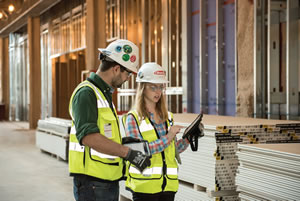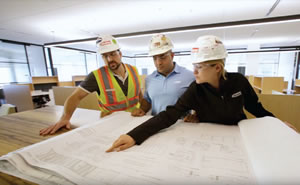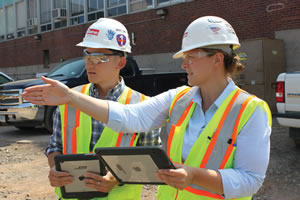Deciding What Building Materials to Specify

PHOTO COURTESY OF GILBANE BUILDING COMPANY
Building a new school is a lengthy,
multi-layered process, requiring input from and strong communication
among team members. To believe less is to be
naïve, and school administrators are anything but naïve. One portion
of the process includes determining what materials to use, and
why. Here are some guidelines to help you through the decisionmaking,
ensuring you choose the best products, resulting in a
beautiful, effective facility lasting well beyond its projected years.
What Is the Process Structure?
It would be nice to be able to say, “Here are the steps to follow to
choose the right materials for your next construction project.” Unfortunately,
it isn’t always that easy, because there are different types
of projects.
In some cases, the project architect provides school administrators
with material options, and they make the selection. In
other cases, there is a collaborative environment where the entire
project management team is involved, including the architect,
engineers, construction manager, materials suppliers, interior
designers and school administrators. “This happens often, and
especially on our big projects, such as New Haven, Conn. schools
and Rochester, N.Y. schools,” says Susan Hentschel Tully, senior
project manager and K-12 Center of Excellence/Market Leader for
Gilbane Building Company, Philadelphia.
In both of these situations, materials decisions are made during
design. Administrators can often expect three options to be
presented: one with a low up-front cost, one with a longer-term life
expectancy and lower maintenance cost, and one in between.
And then there are large school districts that have a set of
building standards in which materials are determined in the master
planning stage for the entire district before thoughts are put
into place about how each individual school will look. “That’s done
well in advance of the design of any schools,” says Tully. “When
this is the case, there really is only one predetermined option, with
choices given to finishes, colors or patterns, which are determined
during design.”

PHOTO COURTESY OF GILBANE BUILDING COMPANY
New School. Children observe the construction of their new school. But
before ground could be broken, someone had to decide what materials
were going to be used to build the facility. Making those types of decisions
requires a team effort — in most cases a large team. In the case of the
Billerica Memorial High School, in Massachusetts, that team included staff
from Perkins+Will, the superintendent, principal, facility director, building
committee, owner product manager (OPM) and construction manager (CM).
On many projects it is also wise to include a group of students and staff.
One benefit of design standards is eliminating issues with replacement
parts being able to be purchased in the future. Another
is maintenance consistency. A third is time savings during the
design process.
Who Is Involved in the Process?
Knowing what materials to use requires a team effort — a large
team, in fact, because there are different areas of expertise that
have to be addressed. Each team member is vital to ensuring the
right products are chosen.
“We involved everyone early on,” says Brooke Trivas, principal
and K-12 practice leader at Perkins+Will’s Boston office,
referencing the new Billerica Memorial High School (BMHS) in Massachusetts (that officially broke ground on March 27.) “This
included the team from our office, the superintendent, principal,
facility director, building committee, owner product manager
(OPM) and construction manager (CM).” She also notes that,
on some projects, they invite a group of students and key staff
to look at the building design and color palette to gain buy-in
from the school users. The 324,000-square-foot BMHS, accommodating
grades 8-12, is estimated to be complete in 2020, with a
$124,000 construction cost.
Each of the team members brings a different area of expertise
to the decision-making process. For instance, the superintendent
brings expertise of budget and goals: he wants to choose products
that ensure the project stays on budget and fulfills its goals. In the
case of Billerica, the design goals were to honor the past and aim
for the future, because the community has a deep history, and
they want to look at both their history and their future. The facility
director brings expertise of preventive and restorative maintenance.
He wants to choose reliable products that his staff is able to
maintain in terms of training, budget and time.
Continuing the example, Ryan Lynch, project executive for
Shawmut Design & Construction’s Boston office, notes that, “The
construction manager’s role is to work collaboratively with the
design team and owner to ensure that the products selected are
appropriate for the project. This appropriateness is determined by
multiple factors, including cost, durability, product availability/manufacturer stability and sustainability.”

PHOTO COURTESY OF GILBANE BUILDING COMPANY
And, yes, the team even includes supplier expertise. Not all
suppliers offer the exact same product; often there are subtle differences
that can have a huge impact on whether a product is right
for a project. For example, Terry Westerman, vice president of
Marketing for ClarkDietrich Building Systems, Inc., West Chester,
Ohio, which offers a comprehensive lineup of steel construction
products and services, works closely with architects and specifiers
to ensure performance matches products and systems. This
can be fire rating, sound ratings or limiting heights. “Included is
providing information regarding sustainability and any assistance
in achieving LEED points,” he adds.
The best way for the team to work together is collaboratively.
“The owners should be very open and honest about what the budget
is and what’s important in terms of material selection,” says
Tully. “When selecting materials, they must be able to prioritize
what they want and what concessions they’re willing to make so
the team has a starting point to make recommendations based
on the budget. Then the owners can set the standards with the
construction manager, architect and materials supplier to work
together to establish values for different options.”
How to Decide What Materials to Use
According to Trivas, a large part of deciding what materials
to use is based on a process that prioritizes materials values,
understanding that each project, and even different parts of an
overall project, may have different priorities. There are six major
considerations.
1. One consideration is the material’s durability. For example,
upholstery is graded according to Wyzenbeek rubs: light use
is 6,000 to 9,000 double rubs, medium use is 9,000 to 15,000
double rubs and heavy use is 15,000+ double rubs.
2. Another consideration is budget, including product and
installation cost. “When considering initial costs,” says Lynch, “products that are not custom and are commonly installed benefit
from a labor force that is familiar with the installation and
has developed an efficiency in the installation phases — these
efficiencies directly impact the bidding subcontractor market in
a positive direction.”
3. Lifecycle cost is more important for some administrators than
others. “It’s a reoccurring cost through the life of a project,” says
Trivas. “It’s important to understand that a product may cost
a bit more upfront, but may cost less to maintain through the
duration of the installation.”
4. Sustainability is another consideration. This is the impact on
the environment to produce the product and the product’s impact
on building users, such as whether the product off-gasses.
“LEED v4 has a Health Product Declaration (HPD),” says Trivas,
“which reports the material contents of building products
and the health effects associated with the materials. This is
important because LEED’s V4 material resource credit has to
show the HPDs, and the industry has not yet caught up to these
requirements.”
5. Ease of the repair and replacement of the material by the maintenance
personnel is the fifth consideration. This answers the question,
How complicated is the product to repair and/or replace? For
example, in choosing carpet tiles, individual tiles are more easily
replaced than is an entire room of broadloom carpet.
6. Finally, there’s aesthetics. “We say we’re designing experiences, not just
facilities,” Trivas explains, “so materials selection completes a story.”

PHOTO COURTESY OF GILBANE BUILDING COMPANY
Lynch hammers home the importance of the decision-making
process: “Schools are designed to a standard that provides decades
of service — each product selected must be able to achieve this
goal as well.”
Getting Real About Material Selection
Before you hit information overload, there are just a few more
things to know about choosing the right materials for your next
school construction project.
1. Think about what’s behind the wall. “Understanding performance
criteria and specialty applications, like how video monitors
and other heavy objects are being mounted and supported,
are important to performance and ongoing maintenance of the
structure,” Westerman says.
2. Manufacturers who are members of strong industry associations
are a solid bet for ensuring high-quality materials.
The Steel Framing Industry Association (SFIA) (sfia.memberclicks.net), Falls Church, Va., the largest organization
for cold-formed steel, is one example. “With a third party testing
program in place, the SFIA members offer a consistent level
of quality and peace of mind,” says Westerman.
3. Ask to see product samples before making a decision. “There
are different thicknesses of rubber tile and a considerable cost
difference in the thicknesses,” says Trivas. “This is a perfect
example of how you have to see a product to really understand
the differences and know how it will wear in your project.”
4. Be open to new ideas. “Don’t rely on what’s familiar and what
you did the last time,” says Trivas, “because it may no longer be
the best option and the most cost-effective current option. Listen
to the team to understand what new products are available
and how they may be better than the old.”
5. If you’re on board with lifecycle costs over first costs, be
prepared to bring the rest of the administrative team on
board. “The best argument is the return on investment,”
says Tully, “supported by examples. Vinyl composite tile
(VCT) is one example. It has a low upfront cost, but is easily
damaged and has to be replaced, and it has to be waxed
regularly. Terrazzo, on the other hand, costs more upfront,
but it does not have to be replaced often, and it requires less
maintenance.”
Armed with this material decision-making knowledge, you’re
well on your way to making effective material choices for your new
school — decisions about which you can rest assured.
LOOKING FOR DANGERS
IN THE MATERIALS SELECTION PROCESS
Brooke Trivas, principal and K-12 practice leader at Perkins+Will’s
Boston office, indicates three dangers to avoid in the materials selection
process.
1. Lack of longevity: “It’s important to prioritize the budget in
terms of high-traffic areas,” says Trivas, “being careful to understand
the longevity of the products you choose for the location in
which they’re used. For example, drywall does not have longevity
when used in a corridor.”
2. Long lead times: Some materials have a long lead time, such as
those coming from Europe. This can be detrimental when you’re
working on a tight timeline. “Not only might it make initial installation
difficult,” Trivas says, “but it may also make replacement
difficult.”
3. Choosing unhealthy products: “I hope all administrators are
careful to not use materials unhealthy to the environment, to the
people producing them and to building occupants,” says Trivas.
“Choose products that are healthy, pure and honest.” Perkins+Will
has on its website an open source precautionary list of materials
harmful to humans, animals and the environment. It includes suggested
alternatives.
This article originally appeared in the issue of .